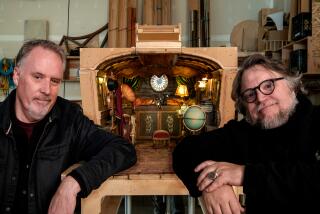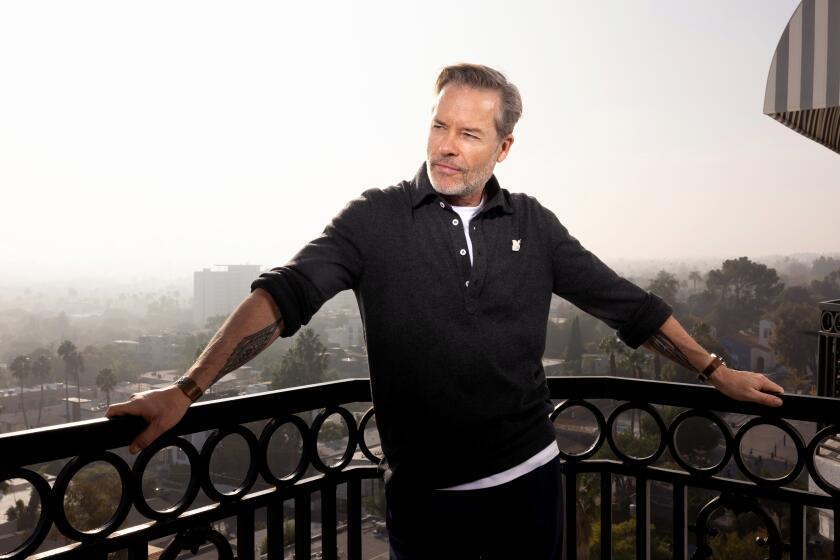Last of Disney’s ‘Nine Old Men’ dies
- Share via
Oliver Martin “Ollie” Johnston Jr., the last living member of the celebrated “Nine Old Men” of Disney animation whose work set the standard by which all character animation is judged and a recipient of the National Medal of Arts, has died. He was 95.
Johnston died Monday afternoon of natural causes at a long-term care facility in Sequim, Wash., according to a news release from Howard E. Green, vice president of studio communications for Walt Disney Studios.
Although Johnston made noteworthy contributions to short cartoons, including “Pluto’s Judgment Day” (1935), “Mickey’s Rival” (1936) and “Reason and Emotion” (1943), his fame rested on his work on the Disney features, beginning with his animation of the Seven Dwarfs and Pinocchio.
He helped to create such celebrated characters as Bambi and Thumper in “Bambi” (1942), the Three Good Fairies in “Sleeping Beauty” (1959), Pongo and Perdita in “101 Dalmatians” (1961), and Mowgli and Baloo in “The Jungle Book” (1967).
Johnston’s work included such memorable moments as Pinocchio’s nose growing when he lied to the Blue Fairy in the 1940 movie; Thumper reciting his lesson about eating clover greens under his mother’s watchful eye in “Bambi”; the befuddled Mr. Smee trying to follow Captain Hook’s orders in “Peter Pan” (1953); Baloo performing “The Bare Necessities” in “The Jungle Book”; and the penguin-waiters serving Julie Andrews and Dick Van Dyke in “Mary Poppins” (1964).
Oscar-winning animator and historian John Canemaker said, “Ollie’s death truly marks the end of the ‘Golden Age’ of hand-drawn Disney character animation that blossomed in the 1930s. He was a great and nuanced animator who could handle sentiment and comedy with equal aplomb, as well as a sweet and generous mentor to many.”
Roy E. Disney, director emeritus and consultant for the Walt Disney Co., called Johnston “one of the real pioneers of our art.”
“One of Ollie’s strongest beliefs was that his character should think first, then act . . . and they all did,” Disney, the nephew of Walt Disney, said in a statement. “He brought warmth and wit and sly humor and a wonderful gentleness to every character he animated. He brought those same qualities to his life, and to all of our lives who knew him.”
Born in Palo Alto on Oct. 31, 1912, Johnston was the son of the head of the Romance languages department at Stanford University.
He studied art at Stanford, where he met Frank Thomas, who would become his lifelong friend and another of the Nine Old Men. Walt Disney gave the name to his key group of animators, playing off President Franklin D. Roosevelt’s description of the Supreme Court.
After graduating, Johnston followed Thomas to Los Angeles, where they studied at the Chouinard Art Institute. Thomas went to work at Disney’s studio on Hyperion Avenue in the Silver Lake area of Los Angeles in September 1934; Johnston joined the studio in January 1935. He quickly rose through the artistic ranks, working as an assistant to Fred Moore, who supervised the animation of the Seven Dwarfs in “Snow White” (1937).
Disney animator Andreas Deja, whose work includes Lilo in “Lilo and Stitch” (2002), praised the subtlety of Johnston’s work in “Bambi,” especially the scene in which Bambi sees his father, the Great Prince of the Forest, for the first time.
“On the meadow, Bambi sees the Great Prince and gives him this big smile,” Deja said. “The Great Prince passes by, very serious and stern, and very slowly Bambi’s expression changes: He drops his ears slightly and looks a little scared. It’s a scene that’s so subtle, you think it couldn’t be done in animation: When you want to show a change, you have to make it graphically clear and Bambi is undergoing such a subtle mood shift. But Ollie handled it with such tact and sensitivity.”
“In Ollie’s scenes, all the changes of emotion took place through subtle expressions of the character’s eyes and the mouth and hands,” said Glen Keane, who animated Beast in “Beauty and the Beast” (1991). “Ollie’s drawings looked as if his pencil had just kissed the paper to coax the characters out. Ollie really felt with his characters: His animation wasn’t an intellectual thing, it came from something inside of him.”
For one of his last assignments, Johnston animated Rufus, the kindly old cat who comforts Penny at the orphanage in “The Rescuers” (1977). Many animators believe Rufus was a partial self-caricature, as Johnston wore a similar mustache and glasses. During production on “Rescuers,” Johnston helped to train a new generation of animators at the Disney Studio, including Keane.
“Ollie was a great mentor: He would give me something to do that was beyond me, then make sure that I had everything I needed to do it,” Keane said. “He knew that as a student, you had to have little successes along the way if you were ever going to make it. I really appreciate the patience that he showed.”
After retiring from the studio in 1978, Johnston and Thomas co-wrote four books: “Disney Animation: The Illusion of Life” (1981), “Too Funny for Words” (1987), “Walt Disney’s Bambi: The Story and the Film” (1990) and “The Disney Villain” (1993).
John Lasseter, chief creative officer for Walt Disney and Pixar Animation Studios and a longtime friend of Johnston, said: “Aside from being one of the greatest animators of all time, he and Frank [Thomas] were so incredibly giving and spent so much time creating the bible of animation -- ‘Disney Animation: The Illusion of Life’ -- which has had such a huge impact on so many animators over the years.”
Johnston and Thomas’ decades of work and friendship were the subject of the 1995 documentary “Frank and Ollie,” produced by Thomas’ son and daughter-in-law, Theodore Thomas and Kuniko Okubo. In addition to awards from numerous animation festivals and organizations, the pair were honored by the Academy of the Motion Picture Arts and Sciences in 2003 when “Frank and Ollie: Drawn Together” was the subject of the eighth Marc Davis Lecture on Animation. Johnston was awarded the National Medal of Arts in November 2005 by President Bush.
In addition to his work as an animator, Johnston was a lifelong railroad enthusiast, a passion he shared with Disney; Ward Kimball, another of the Nine Old Men; and “Toy Story” director Lasseter. In 1946, he built a 1-inch scale steam-driven train and a track that ran around his yard in Flintridge. Twenty-two years later, he bought a seven-ton 1901 H.K. Porter steam locomotive, which he lovingly restored and christened the Marie E., after his wife. The full-sized train ran on a half-mile of track at the vacation property the Johnston and Thomas families shared in the hills near Julian, Calif.
Johnston’s wife of 63 years, the former Marie Worthey, died in 2005; Thomas died in 2004 at 92.
Johnston is survived by his two sons: Ken Johnston and his wife Carolyn; and Rick Johnston and his wife Teya. The funeral will be private.
Instead of flowers, the family suggests donations be made to CalArts, the World Wildlife Fund or Natural Resources Defense Council.
Walt Disney Studiosis planning a life celebration with details to be announced.
--
More to Read
Only good movies
Get the Indie Focus newsletter, Mark Olsen's weekly guide to the world of cinema.
You may occasionally receive promotional content from the Los Angeles Times.










